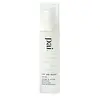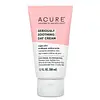What's inside
What's inside
 Key Ingredients
Key Ingredients

 Benefits
Benefits

 Concerns
Concerns

 Ingredients Side-by-side
Ingredients Side-by-side

Water
Skin ConditioningSimmondsia Chinensis Seed Oil
EmollientPersea Gratissima Oil
Skin ConditioningCarthamus Tinctorius Seed Oil
MaskingCetearyl Alcohol
EmollientGlycerin
HumectantBorago Officinalis Seed Oil
EmollientButyrospermum Parkii Butter
Skin ConditioningCetearyl Glucoside
EmulsifyingPelargonium Graveolens Oil
MaskingLitsea Cubeba Fruit Oil
MaskingJasminum Grandiflorum Flower Extract
MaskingTocopherol
AntioxidantHelianthus Annuus Seed Oil
EmollientSodium Levulinate
Skin ConditioningSodium Anisate
AntimicrobialSodium Stearoyl Glutamate
CleansingSodium Caproyl/Lauroyl Lactylate
AntimicrobialLactic Acid
BufferingBeta-Sitosterol
Emulsion StabilisingSqualene
EmollientWater, Simmondsia Chinensis Seed Oil, Persea Gratissima Oil, Carthamus Tinctorius Seed Oil, Cetearyl Alcohol, Glycerin, Borago Officinalis Seed Oil, Butyrospermum Parkii Butter, Cetearyl Glucoside, Pelargonium Graveolens Oil, Litsea Cubeba Fruit Oil, Jasminum Grandiflorum Flower Extract, Tocopherol, Helianthus Annuus Seed Oil, Sodium Levulinate, Sodium Anisate, Sodium Stearoyl Glutamate, Sodium Caproyl/Lauroyl Lactylate, Lactic Acid, Beta-Sitosterol, Squalene
Water
Skin ConditioningAloe Barbadensis Leaf Juice
Skin ConditioningCetearyl Olivate
Sorbitan Olivate
EmulsifyingGlycerin
HumectantHelianthus Annuus Seed Oil
EmollientCarthamus Tinctorius Seed Oil
MaskingGlyceryl Laurate
EmollientCocoglycerides
EmollientGlyceryl Stearate Se
EmulsifyingColloidal Oatmeal
AbsorbentArgania Spinosa Kernel Oil
EmollientLimnanthes Alba Seed Oil
Skin ConditioningTheobroma Cacao Seed Butter
EmollientHippophae Rhamnoides Seed Oil
Skin ProtectingRosa Canina Fruit Oil
EmollientAspalathus Linearis Leaf Extract
Skin ConditioningButyrospermum Parkii Butter
Skin ConditioningOlea Europaea Fruit Oil
MaskingGlycerophosphoinositol Lysine
Squalane
EmollientChamomilla Recutita Flower Oil
MaskingXanthan Gum
EmulsifyingTocopherol
AntioxidantSodium Levulinate
Skin ConditioningPotassium Sorbate
PreservativeEthylhexylglycerin
Skin ConditioningWater, Aloe Barbadensis Leaf Juice, Cetearyl Olivate, Sorbitan Olivate, Glycerin, Helianthus Annuus Seed Oil, Carthamus Tinctorius Seed Oil, Glyceryl Laurate, Cocoglycerides, Glyceryl Stearate Se, Colloidal Oatmeal, Argania Spinosa Kernel Oil, Limnanthes Alba Seed Oil, Theobroma Cacao Seed Butter, Hippophae Rhamnoides Seed Oil, Rosa Canina Fruit Oil, Aspalathus Linearis Leaf Extract, Butyrospermum Parkii Butter, Olea Europaea Fruit Oil, Glycerophosphoinositol Lysine, Squalane, Chamomilla Recutita Flower Oil, Xanthan Gum, Tocopherol, Sodium Levulinate, Potassium Sorbate, Ethylhexylglycerin
 Reviews
Reviews

Ingredients Explained
These ingredients are found in both products.
Ingredients higher up in an ingredient list are typically present in a larger amount.
This ingredient is also known as shea butter. It is an effective skin hydrator and emollient.
Emollients help soothe and soften your skin. It does this by creating a protective film on your skin. This barrier helps trap moisture and keeps your skin hydrated. Emollients may be effective at treating dry or itchy skin.
Shea butter is rich in antioxidants. Antioxidants help fight free-radicals, or molecules that may harm the body. It is also full of fatty acids including stearic acid and linoleic acid. These acids help replenish the skin and keep skin moisturized.
While Shea Butter has an SPF rating of about 3-4, it is not a sunscreen replacement.
Shea butter may not be fungal acne safe. We recommend speaking with a professional if you have any concerns.
Learn more about Butyrospermum Parkii ButterCarthamus tinctorius seed oil comes from safflower, one of humanity's oldest crops.
Safflower seed oil contains a high percentage of linoleic acid and oleic acid. It also contains Vitamin E. These three components are effective moisturizers.
Vitamin E helps nourish your skin's lipid barrier. It is also a potent antioxidant. Antioxidants help fight free-radical molecules, or unstable molecules that may damage your skin cells.
Due to its high fatty acid content, this ingredient may not be malassezia folliculitis safe.
Thoughout history, safflower has been used for dying fabrics and in food as a saffron substitute.
Learn more about Carthamus Tinctorius Seed OilGlycerin is already naturally found in your skin. It helps moisturize and protect your skin.
A study from 2016 found glycerin to be more effective as a humectant than AHAs and hyaluronic acid.
As a humectant, it helps the skin stay hydrated by pulling moisture to your skin. The low molecular weight of glycerin allows it to pull moisture into the deeper layers of your skin.
Hydrated skin improves your skin barrier; Your skin barrier helps protect against irritants and bacteria.
Glycerin has also been found to have antimicrobial and antiviral properties. Due to these properties, glycerin is often used in wound and burn treatments.
In cosmetics, glycerin is usually derived from plants such as soybean or palm. However, it can also be sourced from animals, such as tallow or animal fat.
This ingredient is organic, colorless, odorless, and non-toxic.
Glycerin is the name for this ingredient in American English. British English uses Glycerol/Glycerine.
Learn more about GlycerinHelianthus Annuus Seed Oil is the oil derived from the seeds of a Sunflower. Sunflower seed oil is non-fragrant. It is an emollient, meaning it helps to soften the skin.
Sunflower seed oil contains many fatty acids. The fatty acids found in sunflower seeds include (from highest amount to least): linoleic acid, myristic acid, palmitic acid, stearic acid, arachidic acid, oleic acid, and linolenic acid.
These fatty acids help the skin create ceramides. Ceramides play a role in repairing the skin barrier.
Helianthus Annuus Seed Oil helps moisturize the skin. This in turn helps the skin look more rejuvenated and smoother.
Sunflowers are rich in vitamin E.
Historians believe Indigenous cultures of North America domesticated sunflowers before corn. Thus they relied on sunflower oil for a variety of uses. One such use is moisturizing skin and hair.
Sunflower seed oil may not be fungal acne safe. We recommend speaking with a professional if you have any concerns.
Learn more about Helianthus Annuus Seed OilSodium levulinate is the a sodium salt of Levulinic Acid. If dissolved in an aqueous solution, the two ingredients become identical.
It is a skin conditioning agent, meaning it helps soften and hydrate your skin.
According to Cosmetic Ingredient Review, the highest amounts of sodium levulinate are found in mouthwashes at 0.62%.
Learn more about Sodium LevulinateTocopherol (also known as Vitamin E) is a common antioxidant used to help protect the skin from free-radicals and strengthen the skin barrier. It's also fat soluble - this means our skin is great at absorbing it.
Vitamin E also helps keep your natural skin lipids healthy. Your lipid skin barrier naturally consists of lipids, ceramides, and fatty acids. Vitamin E offers extra protection for your skin’s lipid barrier, keeping your skin healthy and nourished.
Another benefit is a bit of UV protection. Vitamin E helps reduce the damage caused by UVB rays. (It should not replace your sunscreen). Combining it with Vitamin C can decrease sunburned cells and hyperpigmentation after UV exposure.
You might have noticed Vitamin E + C often paired together. This is because it is great at stabilizing Vitamin C. Using the two together helps increase the effectiveness of both ingredients.
There are often claims that Vitamin E can reduce/prevent scarring, but these claims haven't been confirmed by scientific research.
Learn more about TocopherolWater. It's the most common cosmetic ingredient of all. You'll usually see it at the top of ingredient lists, meaning that it makes up the largest part of the product.
So why is it so popular? Water most often acts as a solvent - this means that it helps dissolve other ingredients into the formulation.
You'll also recognize water as that liquid we all need to stay alive. If you see this, drink a glass of water. Stay hydrated!
Learn more about Water